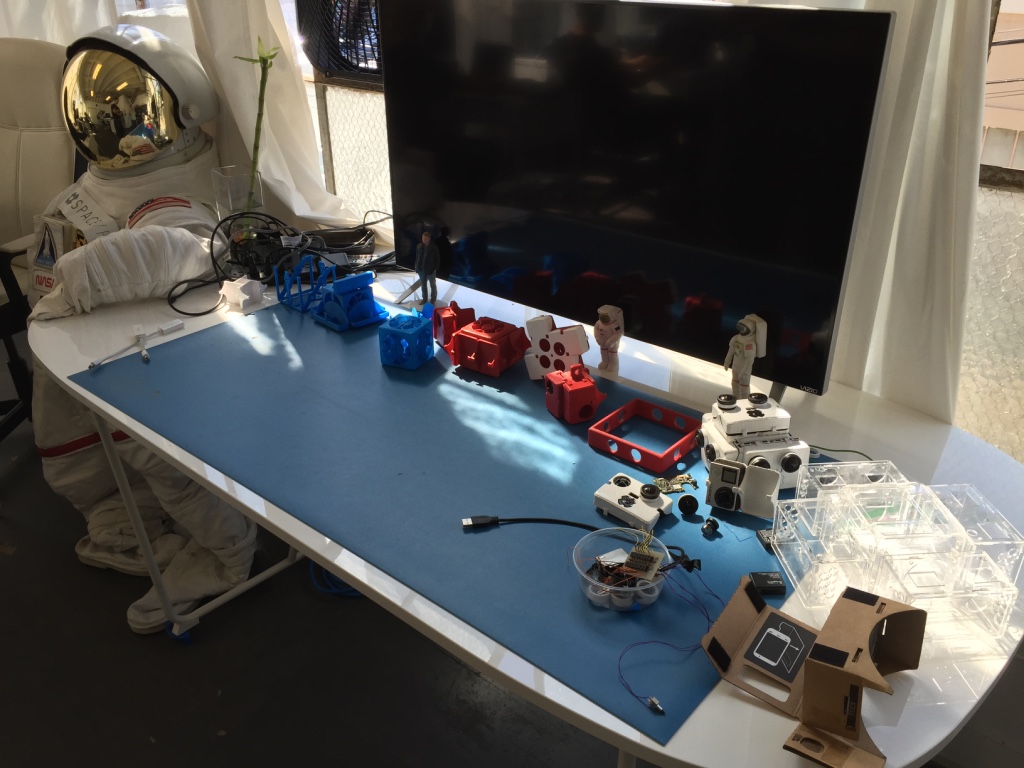Everyone's an Astronaut: Virtual Reality Shoots for the Moon (and Beyond)

SAN FRANCISCO — The world could soon tag along on every space-exploration mission, thanks to the power of virtual reality.
That's the vision of SpaceVR, a startup that aims to launch virtual-reality cameras to the International Space Station (ISS), the moon, Mars and anywhere else that spacecraft may travel in the future.
"We want to take space exploration where it was meant to go — the whole planet experiencing it together," SpaceVR co-founder and chief technical officer Isaac De Souza told Space.com here at the company's headquarters. "When people take their first steps on Mars, there should be a SpaceVR camera there to watch." [Red Planet or Bust: 5 Manned Mars Mission Ideas]
A coming boom
De Souza and his colleagues believe virtual reality (VR) is about to explode, and they're not alone in that assessment.
For example, the research firm KZero Worldswide projects the global VR market will expand from about 200,000 users in 2014 to 170 million by 2018, according to the entertainment site Variety. The technology's potential applications are vast, advocates say, from training for soldiers and pilots to video game play and many other entertainment-oriented options.
VR spaceflight and exploration are on that list as well. Indeed, SpaceX founder and CEO Elon Musk said he's impressed by the VR demonstrations several companies have given him.
"I can sort of imagine, if that's extrapolated into the future, it's really going to super feel like you're there," Musk said in July at the ISS Research and Development Conference (in response to a question posed by a SpaceVR executive). "And I wonder if some people are never going to want to take that [VR headset] off, honestly. I mean, it's pretty entrancing. I do think it'd be quite exciting to do that for space as well."
Breaking space news, the latest updates on rocket launches, skywatching events and more!
SpaceVR gave me a demonstration of the technology last week, showing me a VR view of the June 28 launch of SpaceX's seventh unmanned cargo mission to the space station for NASA, which ended with the explosion of SpaceX's Falcon 9 rocket less than 3 minutes into the flight. Like Musk, I was impressed; with the headset on, it really did feel like I was on site with the spectators, watching the Falcon 9 rise into the skies above Florida's Cape Canaveral Air Force Station.
Making it happen
SpaceVR's plans to bring solar-system exploration to the masses begin in Earth orbit. The company aims to launch a VR camera it calls Overview One to the space station later this year, to provide immersive, 3D views of Earth to subscribers on the ground.
SpaceVR will be able to live stream the camera's footage, with a delay of less than 1 second, company representatives said. (The slight latency will be caused by light's travel time, as well as the time required to stitch images together.)
Overview One consists of 12 GoPro cameras — which SpaceVR has outfitted with much bigger lenses, among other modifications — joined together in a configuration that provides a 360-degree view of the instrument's surroundings.
SpaceVR launched a Kickstarter campaign last week to get Overview One aloft. The company hopes to raise $500,000 by Sept. 9, to cover the camera's launch costs and the first year of its operations. [Update for Sept. 15: SpaceVR has launched a new Kickstarter campaign to fund its "Overview One" project. You can learn more about it here.]
"This is really just the beginning," De Souza said. "Getting to the ISS is important, but that's really just to get our wings."
Indeed, SpaceVR hopes to capture the entire astronaut experience, from training to launch to spacewalks, in virtual reality. And the company wants to put VR cameras aboard missions to the moon, asteroids, Mars and Jupiter in the coming years — anywhere that spacecraft are going, really, if SpaceVR can get the go-ahead from the probes' handlers.
If NASA allows a VR camera to ride along with its Mars 2020 rover, for example, the public could get a whole new appreciation for dramatic and harrowing Red Planet landings, De Souza said.
"We could bring the '7 minutes of terror' in VR," he said.
As of Monday (Aug. 17), SpaceVR's crowdfunding effort had raised about $38,000. But company representatives said they won't give up if they don't hit their $500,000 goal.
"We'll come back with better messaging and try again," SpaceVR CEO and co-founder Ryan Holmes told Space.com.
"For us, it's just a matter of time," De Souza said. "VR in space will happen."
Follow Mike Wall on Twitter @michaeldwall and Google+. Follow us @Spacedotcom, Facebook or Google+. Originally published on Space.com.

Michael Wall is a Senior Space Writer with Space.com and joined the team in 2010. He primarily covers exoplanets, spaceflight and military space, but has been known to dabble in the space art beat. His book about the search for alien life, "Out There," was published on Nov. 13, 2018. Before becoming a science writer, Michael worked as a herpetologist and wildlife biologist. He has a Ph.D. in evolutionary biology from the University of Sydney, Australia, a bachelor's degree from the University of Arizona, and a graduate certificate in science writing from the University of California, Santa Cruz. To find out what his latest project is, you can follow Michael on Twitter.


